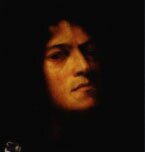

Îãëàâëåíèå ÐåôåðàòûVenetian RenaissanceGiorgione (1476-1510)
Giorgione is considered to be the beginner of Venice Chinquechento, with Him the Venice art rose to Commonitallian meaning, retaining it’s own peculiarity. (7, p. 389) We know very little about him, not withstanding his influence on the future of painting in Venice. (5, p. 215) Certainly, the authority of Vasari is indisputable in the many ways. And, for example, George Holmes, (the) author of fundamental work “Renaissance”, leave Vasari’s view of Giorgione’s humble origin alone. (1, pp. 137-138) But it’s need to say that his view isn’t the only one. Another versions tells us about his belonging to the old patrician clan. At any rate, it’s known for certain he was born in 1477 in a small town Castelfranco. Being a young man he arrived to Venice and went to Giovanni Bellini studio. Since he lived there constantly and died in 1510 from plague. That’s why many of his canvases were burnt with him and with the rest of his property. He got his nickname Giorgione that mean “Great Giorge” for the “greatness of spirit”. Giorgione’s most famous paintings, and those most confidently attributed to him, are the Tempest, Concert of Champetre, and the Sleeping Venus. They all to some extent conform with Vasari’s description of the artist. The Tempest was perhaps connected with reactions to Venice’s political and military plight in the period of invasion by the Leage of Combrai 1508-9.
But many conflicting interpretations have been offered, including the idea that the man and women are Adam and Eve. This is difficult to fit with the fact, revealed by X-rays, that the man was originally a female figure. Giorgione incorporated his figures in a painting of nature in a thunderstorm, capturing not only the landscape, but the atmospheric feeling than pervaded it, in the range of greens and blue-greens with which he painted the plants, the river and the sky. It is his interesting landscape. The Sleeping Venus was the first and the most attractive of reclines nudes in the Venetian Renaissance tradition, less provocative, more mellow and more directly a presentation of a beauty of a woman than Titian’s Venuses. Like them it must have been painted for an erotic purpose but its approach to the female form was more serious. The landscape was partly painted by Titian, who seems in the last years of Giorgione’s life to have rivaled his master. 
Looking back to the Tempest, however, it is not difficult to identify the particular wayward romanticism which was characteristic of Giorgioi and helped to make him a more attractive and original painter than the ambitions professionals who were commoner in the Venetian scene. The style of painting that Giorgione introduced was fundamentally different from the Florentine tradition. He emphasized colour and light rather than the shape of figures and objects, and did not follow preliminary drawings but allowed his design to develop as he proceeded with his brushwork. This approach became common among later Venetians, notably Titian and Tintoretto, and it produced a kind of painting in which the creation of a unified ambience of colour was dominant. Venetians had of course long taken over the sense of spatial depth invented by the Florentines and continued to use it, but the design of space was less important to them. Flemish oil painting and Flemish landscape also had a more obvious effect on the Venetians and, in spite of the parallel of Leonardo, fitted better with their aim of reproducing a world of subtle and rich colouring rather then precisely delineated forms seen in perspective. Giorgione’s little-known carrier is only a part of the general obscurity that veils Venetian art at the beginning of sixteenth century. The limits of Giorgione’s canvases are disputed and several major of them are difficult to assign to individual hainters. Perhaps the most famous is the Concert Champetre, a scene of two musicians in a landscape, apparently conversing and unaware of the presence of two nude females figures. Are they muses existing only in another world? The Concert Champetre is unquestionably one of the outstanding paintings of the Renaissance and one of the greatest works created in Venice in the early sixteenth century but we have no independent information to help us to interpret it. Who are those women? Are they real women that accompanied the young men at their picknick? Most of the art critics say: “No!” They are representatives of another world. May be the young men have just spoken about them? 
May be they are nymphes whom only we, the spectators can see? Mixing the Real and Unreal. Mystery. (7, p. 392) After all we can’t say definetely that it’s Giorgione’s painting. There is a supposition to consider it to be a Titian’s painting. In Venice during the period from 1500 to 1510 there was an atmosphere, partly derived from literature, which cultivated a taste for the Theocritan country idyll, associated with the Greek poet Theodorus, for landscape and for classicism. The precise nature of the movement is unclear but we would probably be right to link it, like the artistic movement at Florence, with an educated aristocracy, devoted to |
|
Êîíêóðñ ðåôåðàòîâ: Òåìà: Venetian Renaissance Àâòîð :  Êðàâöîâ Àðòóð, 11 êëàññ ÁÀÍÍÅÐÛ: |

 The idea that the moment of acceleration in Venetians art came with Giorgione was first stated by Vasari, who appreciated him very highly. I know it’s not a good form to cite much, but in case of trustworthy evidence deficit about Giorgione’s life it’s necessary to do so. Though he was of very humble origin, his manners were gentle and polished throughout his life. Brought up in Venice, he displayed very amorous propensities, and was exceedingly fond of the lute, playing and singing so divinely that he was frequently invited to musical gatherings and meetings of noble persons. He studied drawing and was so fond of it, Nature assisting him to her utmost, and he was so enamoured of the beauty of that art, that he would never introduce anything into his works which he had not drawn from life. So closely did he follow Nature, and so carefully did he imitate her, that not only did he acquire the reputation of having surpassed Gentile and Giovanni Bellini, but he competed with the Tuscan masters, the authors of the modern style. Having seen and greatly admired some things of Leonardo, richly toned and exceedingly dark, Giorgione made them his model, and imitated them carefully in painting oil… Nature had so richly endowed him that he succeeded wonderfully both in oil and fresco, making certain things so soft and harmonious and his shadows so vapourous, that many artists of recognized standing admitted that he was born to infuse his figures with spirit and to counterfeit the freshness of living flesh better than any painter, not in Venice alone but everywher Vasari, who was writing nearly half a century after Giorgione’s death, may have been too remote to know much about him, but the description of his life and work fits the impressions conveyed by the painting now commonly attributed to him. Complaints about the lack sources for Renaissance artist are common, but Giorgione the most enigmatic artist of his rank. He came into prominence about 1500 and certainly died in 1510 but not much is known about the interesting short life beyond what we attempt to deduce from the paintings.
The idea that the moment of acceleration in Venetians art came with Giorgione was first stated by Vasari, who appreciated him very highly. I know it’s not a good form to cite much, but in case of trustworthy evidence deficit about Giorgione’s life it’s necessary to do so. Though he was of very humble origin, his manners were gentle and polished throughout his life. Brought up in Venice, he displayed very amorous propensities, and was exceedingly fond of the lute, playing and singing so divinely that he was frequently invited to musical gatherings and meetings of noble persons. He studied drawing and was so fond of it, Nature assisting him to her utmost, and he was so enamoured of the beauty of that art, that he would never introduce anything into his works which he had not drawn from life. So closely did he follow Nature, and so carefully did he imitate her, that not only did he acquire the reputation of having surpassed Gentile and Giovanni Bellini, but he competed with the Tuscan masters, the authors of the modern style. Having seen and greatly admired some things of Leonardo, richly toned and exceedingly dark, Giorgione made them his model, and imitated them carefully in painting oil… Nature had so richly endowed him that he succeeded wonderfully both in oil and fresco, making certain things so soft and harmonious and his shadows so vapourous, that many artists of recognized standing admitted that he was born to infuse his figures with spirit and to counterfeit the freshness of living flesh better than any painter, not in Venice alone but everywher Vasari, who was writing nearly half a century after Giorgione’s death, may have been too remote to know much about him, but the description of his life and work fits the impressions conveyed by the painting now commonly attributed to him. Complaints about the lack sources for Renaissance artist are common, but Giorgione the most enigmatic artist of his rank. He came into prominence about 1500 and certainly died in 1510 but not much is known about the interesting short life beyond what we attempt to deduce from the paintings. The soldier and the nursing mother in the foreground have been identified be some as representing Fortitude and Chastity in a time of trouble, and the streak of lightning in the thunderous sky of the background as the work of Fortune which the city must suffer. Giorgione may well have entertained ideas like these.
The soldier and the nursing mother in the foreground have been identified be some as representing Fortitude and Chastity in a time of trouble, and the streak of lightning in the thunderous sky of the background as the work of Fortune which the city must suffer. Giorgione may well have entertained ideas like these.